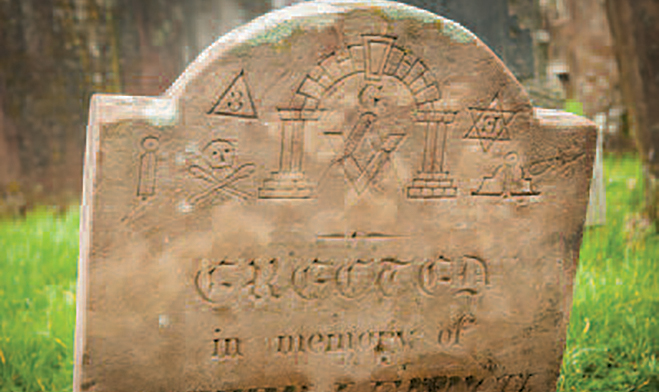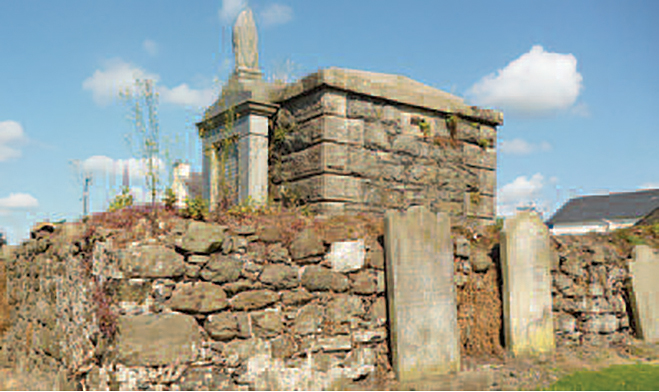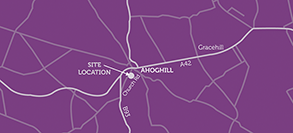Pre-Reformation Trail
Ahoghill
Fourth oldest church in County Antrim.
Access details
The churchyard is located on the Church Road in the village of Ahoghill. The key for the churchyard may be obtained from Logan's Funeral Services, the Diamond, Ahoghill, Monday - Friday, 10am - 5pm.RPC
Grid Reference
Early history of the church
A religious site is believed to have been founded here in the late 500s by Colmanell, a nephew of Columba. Tradition has it that this was the fourth oldest church in County Antrim. Around 1375 the rector of Ahoghill was promoted to Bishop of Connor, suggesting that this was an important parish.
Post reformation history of the church
As the 1600s progressed, the church was described as decayed, not in repair and finally, ruined. It is possible that the church was burnt in the 1641 Rebellion. It is likely that a new church was built on top of the medieval church around 1700. The rebuilding utilised the lower parts of the medieval walls which had survived. In 1768, the church was still in good repair and it was reroofed in 1828. Increasing attendances as a result of the Ulster Religious Revival of 1859 led to the building of a larger church nearby.
The graveyard
Most of the memorials with visible inscriptions date to the 1800s. The gravestone for Rose Hannah who died in 1758 features a large carving of a winged cherub. The gravestone to Peter Leetch who died in 1831 displays carvings associated with freemasonry including the arch and tools. It also includes a skull and crossbones. The monument to the Dickey family, one of the prominent linen families in the area, features a coat of arms.
O'Rorke and Drummond Families
The O’Rorke memorial proclaims the family’s roots in Connacht, as ‘lineal descendants of the O’Rorkes (Breffni) of Dromahaire Castle, County Leitrim’. Eliza O’Rorke married Dr James Lawson Drummond, who died in 1853 and is also buried here. He served as a surgeon in the Royal Navy and practised as a doctor in Belfast. He also taught anatomy, physiology and botany at Royal Belfast Academical Institution. Interested in cultural matters, he was president of the Belfast Literary Society and was one of the founders of the Belfast Natural History and Philosophical Society. In addition to his gravestone in the graveyard, he and his wife are commemorated on memorials in the new church.
Dickey Family
The Dickey family inherited wealth through marriage with the O'Nellans of Ballydonnelan near Toome. The family became one of the prominent linen families in the areas being engaged with five companies. Some members of the family are buried in the graveyard. It is believed that Adam Dickey lived in Ardvenis, the Georgian house opposite the entrance to the Galgorm Manor Hotel.
Gore Family
William Gore who was born around 1881 emigrated to South Africa. There he became the Assistant General Manager of the Standard Bank of South Africa. The Gore Trust erected the Gore Memorial and to this day provide small grants to people from the area who attend university.
Stafford and Hills Families
Edmond Stafford died in 1713 and was buried in this graveyard although no memorial is visible today. He was descended from Sir Francis Stafford who defended the English garrison at Portglenone from 1572. The family made several powerful marriage alliances including with the O'Neills and the Hills' (of Hillsborough, County Down). The Hills and Stafford alliance descended a daughter Anne, who married the Earl of Mornington and became the mother of the 1st Duke of Wellington.
| Churchyard Facts & Figures | |
| First used as a Christian religious site | Believed to be late 500s AD |
| Papal taxation of c.1300 | 20 shillings |
| Church name used in Papal taxation c. 1300 | Achochill |
| Church size | Medieval church - 79 feet by 23 feet 6 inches |
| Discontinued use of church | 1865 |
| Replaced by | Nearby St Colmanell’s Church of Ireland |
| Townland | Carmacmoin |




